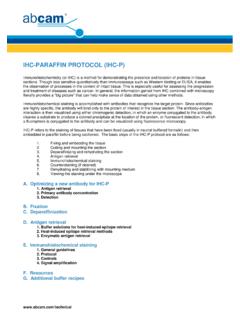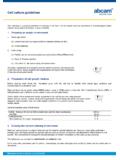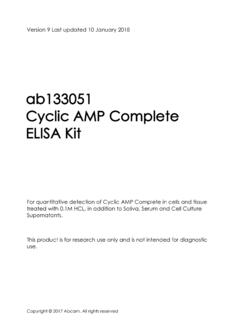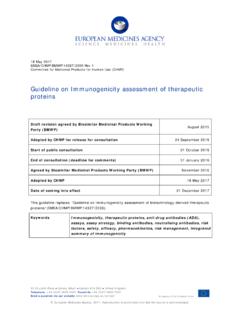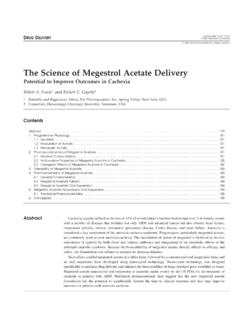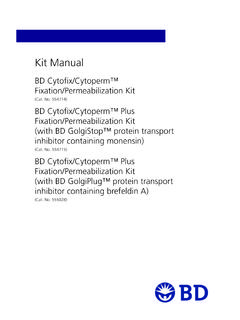Transcription of ELISPOT protocol - abcam.com
1 Discover more at ELISPOT protocol The Enzyme Linked Immunospot technique was developed by Cecil Czerkinskdy in 1983. ELISPOT is used for the detection of secreted proteins, such as cytokines and growth factors. It is therefore used primarily in immunology research in the following areas: Transplantation prediction of infectious risk Vaccine development (IFN gamma) Th1/Th2 analysis Autoimmune disease Cancer tumor antigens Allergy Viral infection monitoring and treatment Cells are grown in 96 well plates with antibody-coated PVDF or nitrocellulose membranes to the wells. First, the membrane is coated with primary antibody. Next, the cells are grown on this membrane and the secreted protein of interest will bind to the antibody. When this is detected using secondary antibody, the protein will be seen in the locality of that secreting cells as a spot of color (one spot = 1 cell).
2 The membranes are then scanned in and analyzed using one of various software programs that are available for this purpose. These are able to quantify the number and percentage of cells secreting the protein . Therefore, immune responses to various stimuli can be quantified and compared. abcam ELISPOT kits The procedure below is a general guideline procedure for ELISPOT . abcam ELISPOT kits have been designed for detection of various cytokines and growth factors from PBMC cells (Peripheral Blood Mononuclear cells). Optimized procedures are supplied with these kits and we recommend that these methods are used. The researcher will, however, still need to optimize the cell numbers used, the length of cell culture incubation and the cell stimulant that is used. ELISPOT pair products will require the researcher to use their own reagents and optimize the procedure.
3 General ELISPOT procedure 1. Prepare PVDF membranes in the 96 well plates by incubating in 70% ethanol for 30 seconds. 2. Coat 96 well ELI plate with capture antibody (diluted in PBS). Incubate at 4oC overnight. 3. Empty the wells, tapping them dry, and wash with PBS ELSIPOT plates should be handled more carefully than ELISA plates. When tapping dry, do this gently. Do NOT use plate washer at this stage. 4. Block the plates by adding 100ul per well 2% dry skim milk. Incubate 2 hours at room temperature. 5. Wash wells in PBS once. If necessary, the plates can be stored at this stage. Wash twice in PBS and leave to dry. Store at 4oC for not more than 2 weeks. 6. Prepare PBMCs from fresh blood on a Ficoll gradient. Count the cells (make sure they are over 95% viable). Dilute cells to the required concentration and add cell suspension to wells.
4 If optimizing the assay for cell number, dilute 1:2 down the plate as in an ELISA. DO NOT SHAKE THE PLATES. The number of cells will require optimization. For example, if a low percentage of cells are expected to secrete the target cytokine, a larger cell number will be required. Refer to specific target kit protocols for recommendations on assay controls and cell number per well. Cell numbers should usually range between 1X105 to 2X105 cells per well. Discover more at 7. Culture overnight 37oC in CO2 incubator. DO NOT SHAKE THE PLATES *If cells take time to respond to stimulation, please see indirect method below. a. Don t move the plates while the cells are culturing. This will lead to snail trail spots that will not be well defined. b. Don t stack the plates if you have more than one.
5 The temperature will not even out across the well and each well will not be at the same temperature, giving an edging effect as cells will respond less well in the centre of the plate where it is cooler. 8. During the overnight incubation the cells will secrete cytokine, which will become bound to the primary antibody. 9. Wash cells and unbound cytokine away by incubating with PBS Tween 20 for 10 minutes. Then wash the plates 3 times with PBS Tween 20. Ensure you include Tween 20 in the wash buffer. Some cells will have started attaching after culture overnight ( some stem cells are known to do this). Tween 20 will help wash these off the membrane. Do NOT use a plate washer at this stage. 10. Detect by using the conjugated secondary antibody (Dilute in PBS 1% BSA). Incubate for 1 to 2 hours at room temperature (optimization required).
6 11. Fluorescent detection / enzyme substrate color development. a. The base should be taken off the bottom of the plates washing between substrate and developing solution ( the wash between streptavidin alkaline phosphatase conjugate and BICP/NBT development). Wash both sides of the membrane under running distilled water. This helps to prevent high background as some reagents can leak through the membrane into the bottom tray of the plate. b. Monitor spot formation visually. As soon as the membranes look optimally developed, stop the reaction immediately by gently washing the plate. It is not a good idea to walk away while the spots are developing and the timing for optimal results will be slightly different each time. 12. Wash the plates in distilled water to stop the spot formation (take the base off the plates and wash both sides of the membrane).
7 13. Dry the plates and let membranes dry completely. Spots may become sharper if stored overnight at 4oC at this stage before reading. Membranes can be wrapped and stored at 4oC in the dark. 14. Punch the membranes out of the wells onto a sticky plastic sheet. This step will depend on your plate reader s requirements. Consult plate reader manual. 15. Scan the sheet and analyze the membrane circles analyzed on the computer. Set parameters using the software so computer can distinguish spots: Size/spot diameter Intensity/saturation Circularity/shape Spot development/slope These parameters can be set and saved, then used for repeated experiments for standardized results. * Indirect ELISPOT : If the cells take some time to respond to stimulation, then they will need to be pretreated with the stimulant for an optimized amount of time ( 24 hours) in a separate 96 well culture dish.
8 They can then be transferred to the ELISPOT 96 well assay plate. Discover more at Positive control stimulation Experiments to detect cytokines using ELISPOT will require use of a positive control. In these positive control wells, the cells should be stimulated with an agent known to induce expression of the cytokine being detected. This can then be used to compare to the negative control and to compare as a positive control to other stimulant treatments used. Ensure you are stimulating the PBMC s with the correct stimulant for detection of your target cytokine. LPS Activates Macrophages via the Tool receptor4/complement pathways Stimulation of IL1beta, IL-6 PMA and Ionomycin. Cytokine lymphotoxins Stimulation of IL-2, IL-4
